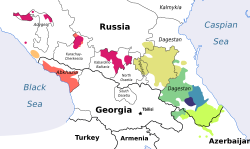Andi language
This article should specify the language of its non-English content, using {{lang}}, {{transliteration}} for transliterated languages, and {{IPA}} for phonetic transcriptions, with an appropriate ISO 639 code. Wikipedia's multilingual support templates may also be used - notably ani for Andi. (September 2024) |
| Andi | |
|---|---|
| къӀаваннаб мицӀцӀи qwavannab miċċi[1][failed verification] | |
| Pronunciation | [qχʼavannab mitsːʼi] |
| Native to | North Caucasus |
| Region | Southern Dagestan |
| Ethnicity | 11,800 Andi (2010 census)[2] |
Native speakers | 21,150 (2020 census)[3] |
| Language codes | |
| ISO 639-3 | ani |
| Glottolog | andi1255 |
| ELP | Andi |
 Andi | |
 Andi is classified as Definitely Endangered by the UNESCO Atlas of the World's Languages in Danger (2010) | |
| Coordinates: 42°43′N 46°17′E / 42.717°N 46.283°E | |
Andi is a Northeast Caucasian language belonging to the Avar–Andic branch spoken by about 5,800 ethnic Andi (2010) in the Botlikh region of Dagestan. The language is spoken in the villages Andi (along the river Andi-Koisu),[4] Gunkha, Gagatl, Ashali, Rikvani, Chanko, Zilo, and Kvanxidatl.[5]
Dialects
[edit]There are four main dialects, Munin, Rikvani, Kvanxidatl, and Gagatl, which appear quite divergent. However, the dialects can be said to vary between villages: the "upper-group" contains Andi, Gagatl, Rikvani, and Zilo (where Andi and Zilo are considered their own dialects), whereas the "lower-group" contains Munin and Kvanxidatl. The upper-group lacks the affricate sound кьI.[5]
Phonology
[edit]Andi has 43 consonants:[6]
| Labial | Dental/ alveolar |
Post- alveolar/ palatal |
Velar | Uvular | Pharyngeal/ Glottal | ||||||
|---|---|---|---|---|---|---|---|---|---|---|---|
| lenis | fortis | lenis | fortis | lenis | fortis | lenis | fortis | ||||
| Nasal | m | n | |||||||||
| Plosive | voiceless | p | t | k | kː | ʔ | |||||
| voiced | b | d | ɡ | ||||||||
| ejective | pʼ | tʼ | kʼ | kːʼ | |||||||
| Affricate | voiceless | tsː | tʃ | tʃː | qχ | ||||||
| voiced | dʒ | ||||||||||
| ejective | tsʼ | tsːʼ | tʃʼ | tʃːʼ | qχʼ | qχːʼ | |||||
| Fricative | voiceless | s | sː | ʃ | ʃː | x | χ | χː | h | ||
| voiced | v | z | ʒ | ʁ | (ʕ) | ||||||
| Lateral | continuant | ɬ | |||||||||
| affricate | tɬː | tɬːʼ | |||||||||
| Trill | r | ||||||||||
| Approximant | l | j | |||||||||
There are five vowels: /a, e, i, o, u/.
Orthography
[edit]Although Andi is usually non written, there are attempts to write the language using Russian Cyrillic script. Speakers generally use Avar or Russian as their literary language(s).[2]
Grammar
[edit]Andi has 7 different series of localization: the meaning "inside" changes by number (singular -ла/-а, plural -хъи: гьакъу-ла 'in a home', гьакъоба-хъи 'in houses'). Number categories are expressed through ablaut (имуво воцци в-усон 'The father found the brother', but имуво воццул в-осон 'The father found the brothers'). In the village Andi, there is a difference between the speech of men and women; a man will say, for example, дин meaning 'I', мин meaning 'you', гьекIа 'person', but a woman will say ден 'I', мен 'you', гьекIва 'person'.[5]
References
[edit]- ^ Margus Kolga; Igor Tõnurist; Lembit Vaba; Jüri Viikberg (1993). "The Andis". The Red Book of the Peoples of the Russian Empire.
- ^ a b Andi language at Ethnologue (19th ed., 2016)

- ^ Том 5. «Национальный состав и владение языками». Таблица 7. Население наиболее многочисленных национальностей по родному языку
- ^ The peoples of the Red Book: Akhvakhs
- ^ a b c "Andijskij Yazyk".
- ^ "Consonant Systems of the North-East Caucasian Languages". Archived from the original on November 16, 2022.
Further reading
[edit]- Verhees, Samira (2020). "Evidentiality in the Rikvani Dialect of Andi". Iran and the Caucasus. 24 (3): 309–324. doi:10.1163/1573384X-20200305. S2CID 225502952.
- Wixman, Ronald (1984). The Peoples of the USSR: An Ethnographic Handbook. Armonk, NY: M. E. Sharpe. p. 11.
- Церцвадзе Ил. Андийский яз. Тб., 1965 (на груз. яз.);
- Алексеев М. Е. Андийский язык // Языки мира. Кавказские языки. М., 1999.
- Этимология 1539 андийских слов в БД «StarLing database server» Sergei Starostin
- [1] // The Book of Luke in Andi Language.
- [2] // Glottolog.org Language Map


